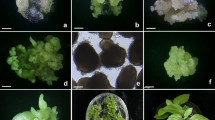Abstract
Russian wildrye [Psathyrostachys juncea (Fisch.) Nevski] is a cool-season forage grass with a broad adaptation to semi-arid regions of North America. In order to explore the potential of biotechnology for genetic improvement of this important forage species, we developed an efficient tissue culture system. Embryogenic calli were induced from mature embryos with an induction frequency in the range of 2–7%. The selected highly embryogenic calli allowed the regeneration of dozens of plants from a single callus. Individual embryogenic calli were then used to establish single genotype-derived suspension cultures. Eighteen embryogenic cell suspension lines were established from three cultivars (Bozoisky-Select, Sawki and Tetracan). A relatively high green plant regeneration frequency, up to 70%, was achieved from plated cell clusters of the established suspension cultures. The regenerated plants were fertile after two winters of vernalization in the field. This efficient plant regeneration system provides a solid basis for generating transgenic plants.
Similar content being viewed by others
Author information
Authors and Affiliations
Additional information
Electronic Publication
Rights and permissions
About this article
Cite this article
Wang, Z., Lehmann, D., Bell, J. et al. Development of an efficient plant regeneration system for Russian wildrye (Psathyrostachys juncea). Plant Cell Rep 20, 797–801 (2002). https://doi.org/10.1007/s00299-001-0410-3
Received:
Revised:
Accepted:
Published:
Issue Date:
DOI: https://doi.org/10.1007/s00299-001-0410-3




